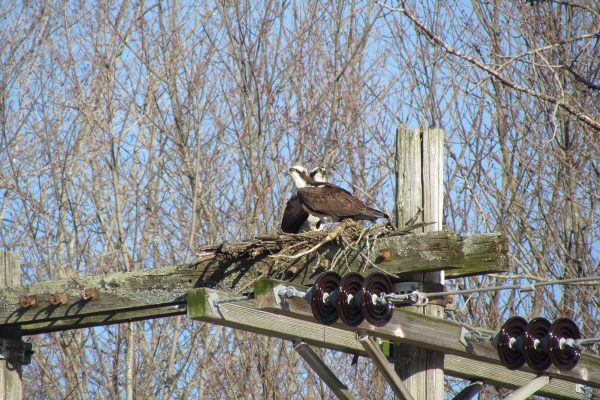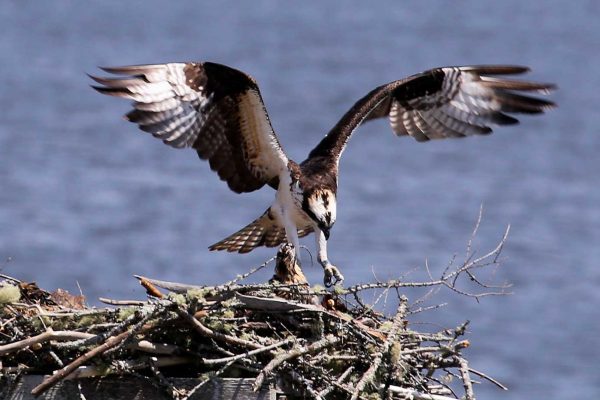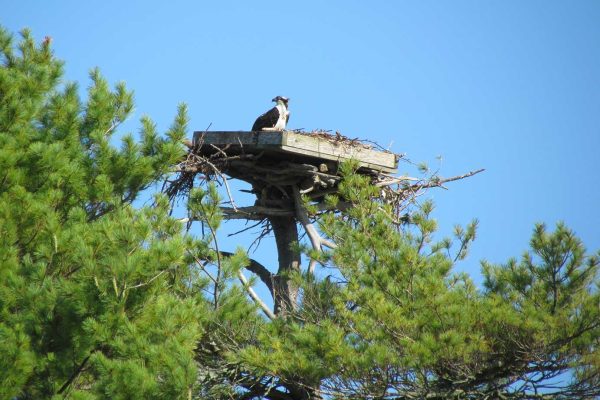Ospreys, clever birds that they are, sometimes make mistakes. They misjudge or mistime a plunge for a fish. They may show up in a place they aren’t typically found. And sometimes they make bad choices as to where to build a nest.

A pair of Ospreys at their nest atop a utility pole. (Photo by Jeff Wells)
This happened recently with an Osprey that tried to set up housekeeping on a light pole, high above Garcelon Field at Bates College in Lewiston. So egregious was this decision that news of it appeared in the Bates College newsletter (which, as parents of a Bates student, we received). The article described how the ambitious bird would fly in with a stick, only to have it crash to the ground. Apparently, there was not enough flat platform area for the sticks to stay put.
If you’re like us, you’ve seen countless Osprey nests on light poles at school athletic fields, and on the cross bars of large utility poles throughout the state. Such places usually work just fine to place a nest. The honorary Bates Bobcat, though, couldn’t make it work. What was it about this Osprey that made him (males usually do most of the work carrying sticks to the nest site) choose an apparently bad nest site? Or was his lack of success attributable to inexperience?
Perhaps the Osprey was in its first year and hadn’t developed the skills necessary to master a tricky nest-building location. Or hoped it could build an attractive nest that would entice a female to mate with him. There were several things that fit the bill for what Ospreys prefer in nest sites.

Ospreys are clever nest builders, but they sometimes make mistakes. (Osprey at Sandy Point, by David Small)
This site is very high, providing some protection for chicks from Great Horned Owls and Bald Eagles looking for an easy snack. Both of those species are known to snatch Osprey chicks from nests. In fact, that particular site would have provided great visibility for spotting any avian predators at quite a distance, and afforded great views of Bates lacrosse games (we swear a few of the Ospreys we’ve seen on nests at some athletic fields and tennis courts actually watch the games!).
The site was also beside a small pond on the college campus that might provide some easy fishing, and the Androscoggin River is only half a mile away—an easy commute to a feeding ground for an Osprey.
It will be interesting to hear whether or not this bird finds another spot nearby and eventually does construct a nest somewhere on the Bates College campus. Ospreys are famous for being persistent in their nest-building and their reconstruction of damaged nests. We were told of and heard many reports of Osprey nests that were removed this winter from long-time traditional spots on powerlines. Nests that are highly visible are a topic of spring conversation even among people who don’t consider themselves “birders”: “The Ospreys are back at [insert name of place here]!” These Osprey fans watch and report on the progress as the birds repair the nest, sit on eggs laid in the nest, bring food to the hatchlings nestled down in the nest, rejoice when the young appear on the edge of the nest, and mark the day when the Ospreys are no longer there, headed south for the winter.
It’s a bad PR move for companies that remove those nests, and it’s also a fruitless one. Said company will be spoken of with disdain on social media and elsewhere. And, inevitably, the Osprey pair will rebuild the nest in or near the same spot, to the delight of their human “guardians.” Utility companies where we lived for a while in upstate New York put platforms above the crossbars on utility poles so the birds would nest there rather than on the crossbars themselves.

An Osprey using a nest platform at a site in Freeport (Photo by Allison Wells)
Some Ospreys will build a new nest in late summer before they depart for the wintering grounds. Are these individuals practicing for next year? Are they building an extra nest in case their primary nest doesn’t last the winter or gets taken over by another Osprey—or even by a Great Horned Owl, as happened to our brother Andrew and sister-in-law’s favorite Osprey nest?
If there’s an Osprey nest in the vicinity, it’s nearly impossible to overlook it. The nests are large and obvious. So naturally there are lots of interesting stories abound about odd and unusual nesting sites and attempts. They are not alone in their strange nest site choices. We’ve seen Mourning Dove nests on the ground, on air conditioners, and on ledges of houses; House Finch nests in dried-out Christmas wreaths still hanging on front doors. Mother Jewell (Allison’s mom) hosted a Carolina Wren in a clothespin bag hanging off her clothesline—Jewell made this discovery upon reaching into the bag, only to have the wren come flashing out! We’ve even heard of Barn Swallow nests on active ferries! We’ll save more of those stories for another column, but feel free to share your stories of odd and unusual bird nesting locations!
—Jeff and Allison Wells










Leave a Reply